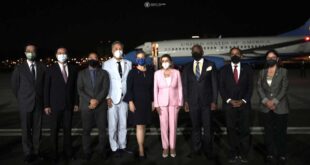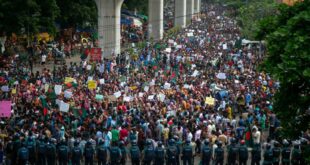Wei Hongxu
As the Federal Reserve accelerates the pace of interest rate hikes and shrinking its balance sheet, interest rates in the U.S. market have also risen. Especially since March, the 10-year U.S. bond yield has risen rapidly, and it has stood at 2.6% on April 6. The rapid rise in ten-year U.S. bond yields has also further narrowed down the U.S.-China interest rate spread. At present, the U.S.-China interest rate spread fell below 20 BP, far from the market consensus of 80 BP to 100 BP “comfort zone”, and has reached a historic low level. The market now believes that if the cyclical dislocation continues in the future, the trend of narrowing spreads between the U.S. and China will also continue, and may even appear inverted. Due to the dominant position of the U.S. dollar in the global currency, the narrowing spread between China and the U.S. is even more challenging for China, as it relates to the trend of the RMB exchange rate, the trend of cross-border capital flows, and the choice of monetary policy.
There is now a market consensus on the reasons for the narrowing of the spread between China and the U.S. In the later stage of the COVID-19 pandemic, China and the U.S. had different pace of economic recovery, as well as differences in monetary policy, which widened the interest rate gap of the two countries. This also brought about RMB appreciation and continued foreign capital inflows into China’s capital markets. With China’s economic pressure increasing and the U.S. economy maintaining a strong recovery, it is inevitable for the Fed to accelerate the pace of policy tightening while China’s monetary policy remains prudent. At present, it seems that the Fed will still accelerate the pace of interest rate hikes to push the benchmark interest rate to reach the 2% target, while China is still facing the demand for monetary policy easing to support economic stability. Under such circumstance, the U.S.-China interest rate gap will continue to narrow, and there is even the possibility of an inversion.
In a general sense, a narrowing of spreads will lead to a narrowing of arbitrage space between currencies, causing capital outflows, which will bring about a trend of exchange rate depreciation and downward volatility in capital markets. Such a trend, if worsened and caused market panic, could affect the stability of the financial system and overall macroeconomy. If we consider the narrowing spreads between China and the U.S. in 2018, the same lies in the economic cycle and policy differences between China and the U.S. The U.S. continued to raise interest rates in 2018, with the federal funds target rate increasing from 1.5% to 2.5%. At that time, China’s economy was under downward pressure due to trade friction, financial risk prevention. It was also the period when there is the economic restructuring of cutting overcapacity, reducing excess inventory, deleveraging, lowering costs, and improving weak links for the Chinese economy. This has forced China to cut rates several times in response, resulting in the 10-year U.S.-China bond spread falling from 1.48% to 0.24%. In this context, coupled with the intensification of the trade war between China and the U.S., the decline in export growth and capital outflows have led to the decline of China’s foreign exchange reserve, exchange rate depreciation, and volatility in the capital market. The most fundamental reason lies in the different economic growth trends between the two sides, and the narrowing of interest rate spreads is also the reflection of differences in economic fundamentals.
In the view of researchers at ANBOUND, the narrowing of the interest rate gap between China and the U.S. this time is very different from the past. First, the inflation issue will have a more significant impact on the exchange rate. The U.S. is currently facing obvious economic overheating, leading to high inflation, which actually makes it difficult for real interest rates to become positive even with the Fed’s rate hike. In fact, since the fourth quarter of last year, as the U.S. tightened and loosened, the U.S.-China interest rate spread began to narrow, but at that time, the RMB exchange rate performed strongly, and international capital has also increased its investment in China’s capital market. It was also during that period of time that ANBOUND pointed out the future change in RMB exchange rate could not be considered simply from the factor of the U.S.-China interest rate spread. Despite the narrowing of the market spread between China and the U.S., if the level of real interest rates affected by changes in their respective levels of inflation are taken into account, the real spread between China and the U.S. is not narrowing, but widening. This means that in the case of rising inflation in the United States, the narrowing of the difference in nominal interest rates between China and the United States will not completely lead to changes in real returns.
Secondly, the influence of external factors on capital flows should be greater than that of spreads. On the one hand, the outflow of funds from the domestic capital market in February and March is also related to the resurgence of the COVID-19. Both international and domestic investors are actually worried that the emerging “static management” prevention and control measures will have a negative impact on the economy and affect the investment returns of the capital market. On the other hand, the outbreak and continuation of the conflict between Russia and Ukraine, as well as the increasing financial sanctions imposed by Europe and the U.S. against Russia, have caused international investors to re-evaluate the geopolitical risks in cross-border investment. Many fear that China will also face a similar heating up of the financial war and thus start to withdraw from its capital market. In fact, the capital outflow phenomenon is actually not entirely caused by the narrowing or inversion of the U.S.-China interest rate spread; instead the deterioration of external risk factors would be the main reason.
Therefore, researchers at ANBOUND are more inclined to believe that the narrowing of the U.S.-China interest rate spread is a reaction to the fundamentals of the U.S.-China economy, which will have a certain impact on China, leading to the withdrawal of arbitrage funds and short-term market volatility. However, the focus of exchange rate, capital outflows, monetary policy adjustments and other issues should be on China’s domestic economic fundamentals, as well as changes in various factors of its capital market. Xu Weihong, global research partner of ANBOUND, stated that the monetary policy of the RMB has been “decoupled” from the U.S. for half a year, and the correlation of market interest rates is not strong. The performance of China’s capital market is more due to the recurrence of the COVID-19 and the suppression of trade and investment, which have worsened market expectations for economic growth.
With the continuous opening up of China’s economy and financial markets, exchange rate fluctuations and capital flows are normal phenomena that need to be viewed from a systemic and long-term perspective. The interest rate spread problem caused by economic and policy differences is only one of the external factors affecting China’s economy, even not a decisive one at that. Thus, both market investors and policy departments need not get too hung up on the changes in the U.S.-China spread, but should focus more on the basic factors that promote economic growth and structural improvement, as well as the changes in the current internal and external development environment. In terms of policy, it is still necessary to enhance the “autonomy” of monetary policy, focus on improving the internal development environment, and promote a virtuous circle of economy and finance, so as to achieve a “soft landing”. In this case, the growth potential of China’s economy and investment opportunities will be attractive to international capital, thereby forming an external cycle conducive to China’s development.
 Geostrategic Media Political Commentary, Analysis, Security, Defense
Geostrategic Media Political Commentary, Analysis, Security, Defense





